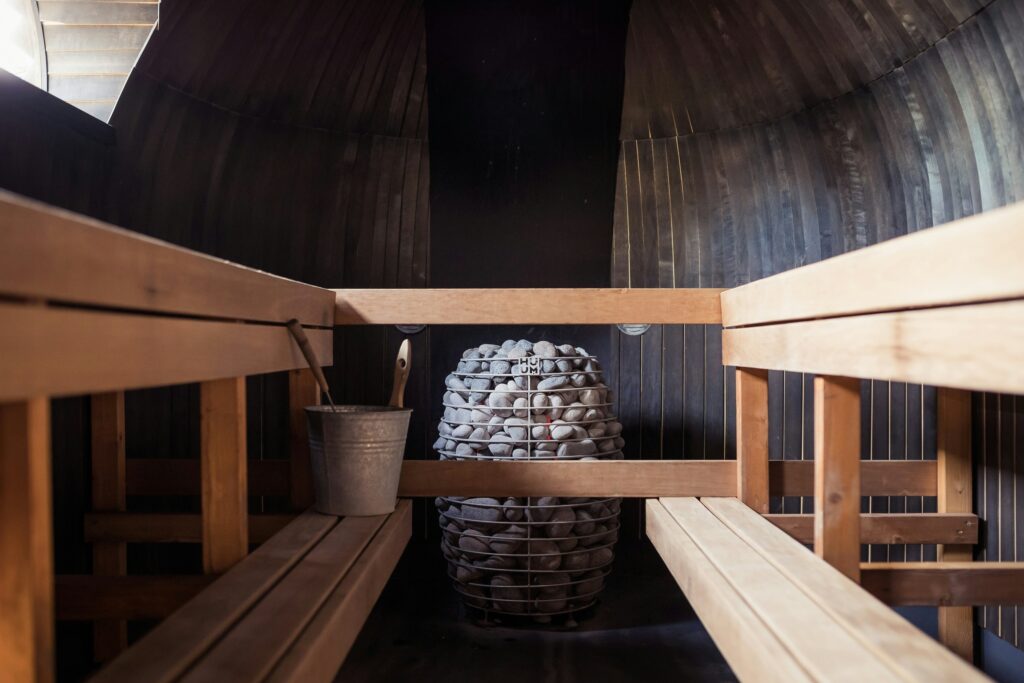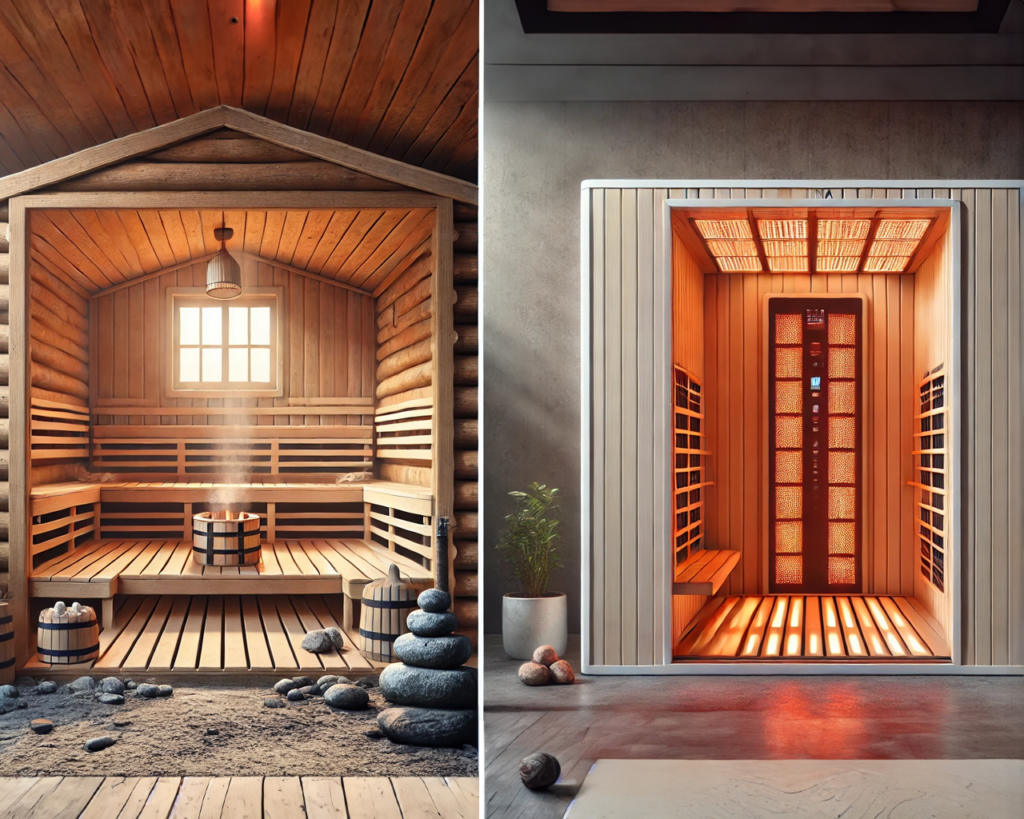
Choosing the right sauna for your home can significantly impact your overall well-being and relaxation. With the growing popularity of both traditional and infrared saunas, understanding their differences is crucial. In this comprehensive guide, we explore the key differences between traditional and infrared saunas, helping you make an informed decision that best suits your needs and lifestyle.
🔥Heating Method
Traditional Sauna: Heats up the air. Stones are heated via electric, gas, or wood heater. In turn, the stones heat the air, indirectly heating up the body through convection and conduction. Water can be poured over the stones to create steam.
Infrared Sauna: Heats up your body without warming up the air around you. Infrared heaters emit infrared light that heats up the body directly.
🌡️💧Temperature, Humidity, and Range
Traditional Sauna: Higher temperatures typically 176°F (80°C). Can have higher humidity levels.
Infrared Sauna: Lower temperatures ranging from 100-150°F or 38-65°C. Low humidity.
⏲️Heating Time
Traditional Sauna: Takes 15-25 minutes to heat up depending on size and heater power because it has to heat up the environment.
Infrared Sauna: Quick. Ready within a few minutes because it does not have to heat up the environment.

🔧Installation
Traditional Sauna: Easy to build and install but more complex than infrared, will require dedicated space. Can build from a kit or build from scratch.
Infrared Sauna: Easy, portable, typically requires less space. Can build from a kit.
⚡Power Requirements
Traditional Sauna: Can run on gas, firewood, or electricity. Electrical heaters will require a dedicated 220V line which will have to be installed by a professional electrician.
Infrared Sauna: Runs on electricity. 110V ~ 120V / 15 Amps outlet with a Standard Household Output.

📱Overall Experience
Traditional Sauna: Traditional saunas are known for their high temperatures, which can be intense and may take some time to acclimate to. This heat can provide a strong sensation of sweating and relaxation. Higher humidity levels due to the water being poured onto the heated stones can create a sensation of humid heat and can be invigorating for some people. The intense heat of traditional saunas can increase heart rate and stimulate circulation. While the intense heat might not be as gentle as that of an infrared sauna, many people find the experience of sweating and then cooling down to be invigorating and stress-relieving.
Infrared Sauna: The use of direct infrared light to heat your body results in a more gentle and penetrating heat. The heat feels more focused on your body rather than on the air around you, which can create a feeling of warmth from within that feels pleasant. This lower temperature can feel more comfortable for people who are sensitive to intense heat. The air in an infrared sauna also tends to be drier and easier to breathe because it’s not superheated. This can be more comfortable for individuals with respiratory issues. Many individuals find that the gentle heat of an infrared sauna promotes relaxation and stress relief. It can be a more soothing experience overall.
👷🏽Maintenance
Traditional Sauna: Requires more frequent cleaning due to higher heat/sweat. Components are simple and easy to replace.
Infrared Sauna: Requires minimal maintenance other than periodic cleaning. If the infrared heater breaks, you will likely not be able to repair it yourself unless you know what you are doing.
💲Cost
Traditional Sauna: Be prepared to spend over $2k plus installation costs for your 220v dedicated electric line if you choose an electric heater.
Infrared Sauna: Typically more affordable compared to traditional sauna models of equivalent size. About 50% to 60% cheaper.
⚕️Therapeutic Benefits
Traditional Sauna: Has been used for hundreds (maybe thousands) of years by many cultures around the world. Hence, there is a lot of data on this type of sauna. I discuss the many benefits of sauna bathing in My Top 5 Sauna Benefits article. Briefly, they include:
- Enhanced quality of sleep
- Faster recovery from soft tissue injuries
- Faster recovery from intense exercise
- Enhances cardiovascular endurance
- Decrease across all-cause mortality
Infrared Sauna: Infrared saunas are a newer technology and therefore the number of studies performed and the quality of the evidence available for this modality is not as significant as that of traditional sauna. Nonetheless, studies have been performed that show great promise. Here is some of that data:
- Ahokas et al. 2023 demonstrated that infrared sauna improves recovery of neuromuscular performance and muscle soreness after resistance exercise training.
- Hussain, et. al. 2022 showed that the physiological effects of infrared sauna bathing are underpinned by thermoregulatory-induced responses, more so than exercise-mimetic cardiorespiratory or cardiovascular activation.
- Sugie, et. al. 2020 demonstrated that a 3-month infrared sauna program can ameliorate geriatric syndrome, the severity of frailty and frailty-related indices in older people.
- This study by Mero, et. al. 2015 highlights the effect of infrared sauna on recovery from strength and endurance training sessions in men.
- This study by Oosterveld, et. al., 2009 showed short-term improvement of pain and stiffness, and a trend towards long-term beneficial effects in patients with rheumatoid arthritis and ankylosing spondylitis.
Although the therapeutic efficacy of traditional sauna vs infrared sauna has not been compared directly in properly designed studies, it is clear that both modalities offer an overlapping range of health-associated benefits that make them appealing to a wide array of individuals. Both types of saunas have been reported to aid in stress reduction, improved circulation, and enhanced cardiovascular function. The heat generated in saunas, whether traditional or infrared, induces a state of relaxation that can help reduce the production of stress hormones and promote a sense of calm. Additionally, the increased heart rate experienced during a sauna session can mimic the benefits of light to moderate exercise, contributing to better blood flow and potentially supporting heart health.
Whether you opt for the classic experience of a traditional sauna or the modern technology-driven approach of an infrared sauna, the potential benefits for your overall well-being are evident.
Additional Considerations for Choosing a Sauna
Space and Location
Traditional Sauna: Typically requires a dedicated space, which can be a limitation if you have a smaller home or apartment. It might also need ventilation and specific safety measures if using a gas or wood heater.
Infrared Sauna: Generally more flexible with space requirements and can often be installed in smaller areas. Some models are even portable, allowing you to set them up in various locations as needed.
User Preferences and Health Conditions
Traditional Sauna: The higher heat and humidity levels can be more challenging for individuals with certain health conditions like respiratory issues or cardiovascular concerns. It’s essential to consult with a healthcare provider before using a traditional sauna if you have any pre-existing health conditions.
Infrared Sauna: The lower heat levels and dry environment can be more comfortable for a broader range of users, including those with respiratory issues. Infrared saunas may also be a better option for older adults or those sensitive to high heat.
Customization and Features
Traditional Sauna: Can be customized with various features like different types of wood, lighting, and seating arrangements. Some models also offer the option to pour water over heated stones to create steam, adding to the traditional sauna experience.
Infrared Sauna: Often come with advanced features like chromotherapy (color light therapy), sound systems, and even Wi-Fi connectivity. These modern features can enhance the overall sauna experience and offer additional health benefits.
FAQs
What are the main differences between traditional and infrared saunas?
Traditional saunas heat the air around you, while infrared saunas use infrared light to directly heat your body. Traditional saunas reach higher temperatures and can have higher humidity levels, whereas infrared saunas operate at lower temperatures with lower humidity.
How long does it take to heat up a sauna?
Traditional saunas take 15-25 minutes to heat up, depending on their size and heater power. Infrared saunas are ready within a few minutes since they do not need to heat the surrounding environment.
Are infrared saunas more energy-efficient?
Yes, infrared saunas are typically more energy-efficient as they require a standard household electrical outlet (110V ~ 120V / 15 Amps) compared to traditional saunas that may need a dedicated 220V line.
Which sauna type is easier to install?
Infrared saunas are generally easier to install and are often portable, requiring less space. Traditional saunas might require more space and a more complex installation process, especially if building from scratch or using a kit.
What are the therapeutic benefits of using a sauna?
Both traditional and infrared saunas offer various health benefits, including enhanced quality of sleep, faster recovery from exercise, improved cardiovascular function, stress reduction, and increased circulation. Infrared saunas are noted for their gentle heat and potential to alleviate muscle soreness.
Summary
Choosing between a traditional and an infrared sauna depends on your preferences and needs. Traditional saunas offer high heat and humidity, providing an intense and invigorating experience. Infrared saunas deliver gentle, penetrating heat, promoting relaxation and stress relief. Both types of saunas provide numerous health benefits, including improved sleep, faster recovery, enhanced cardiovascular health, and stress reduction. Consider the key differences, space requirements, and your personal preferences to select the best sauna for your home.
Disclaimer: This content is provided for educational purposes only and should not be construed as medical advice. Always consult with your primary care physician (PCP) or a qualified healthcare professional before making any changes to your lifestyle, diet, or exercise routine. The information presented in this article is not intended to diagnose, treat, cure, or prevent any disease. Individual results may vary. The author and publisher of this article are not responsible for any adverse effects or consequences resulting from the use or application of the information provided. Please use your own discretion and judgment when implementing any suggestions or recommendations.



